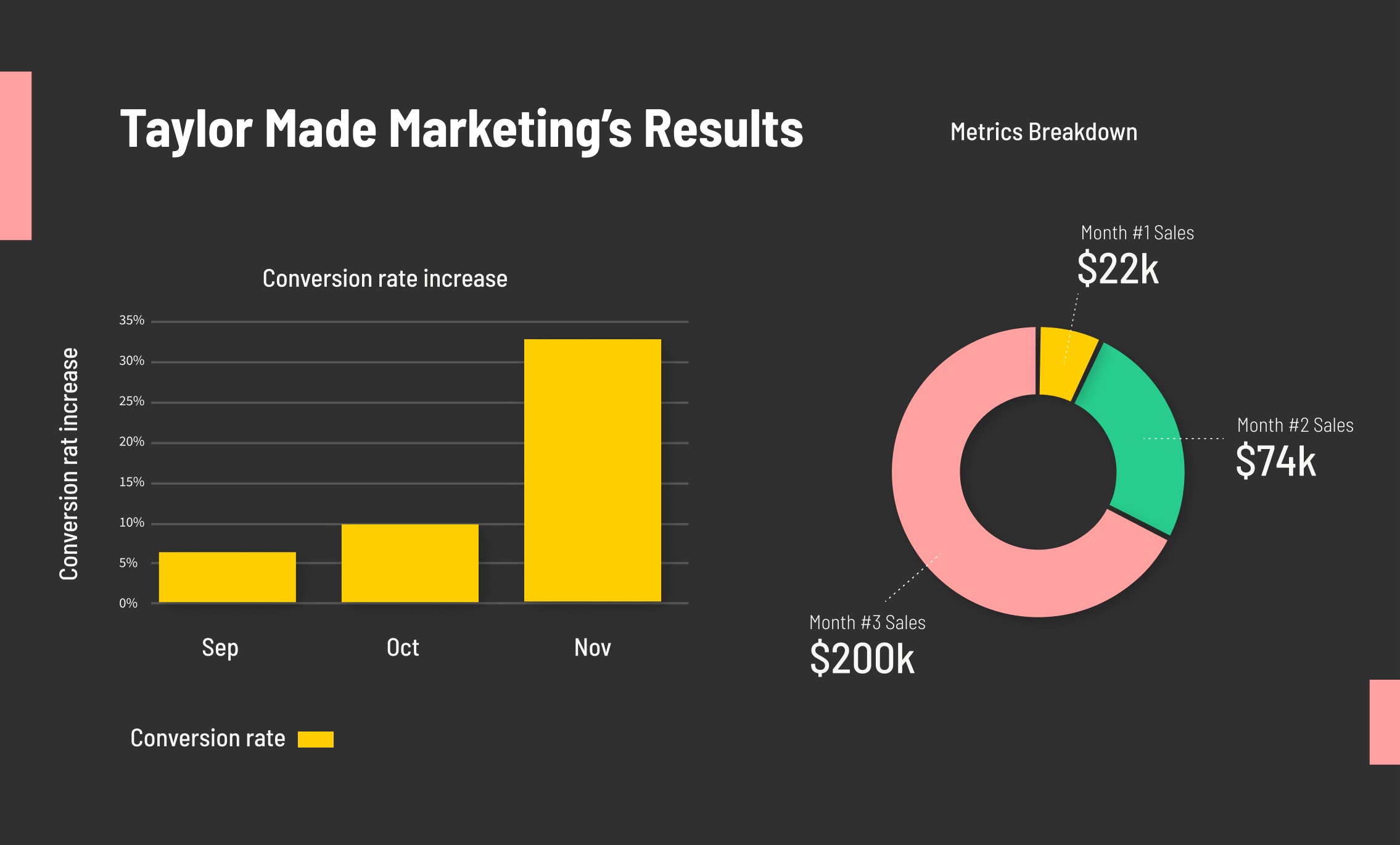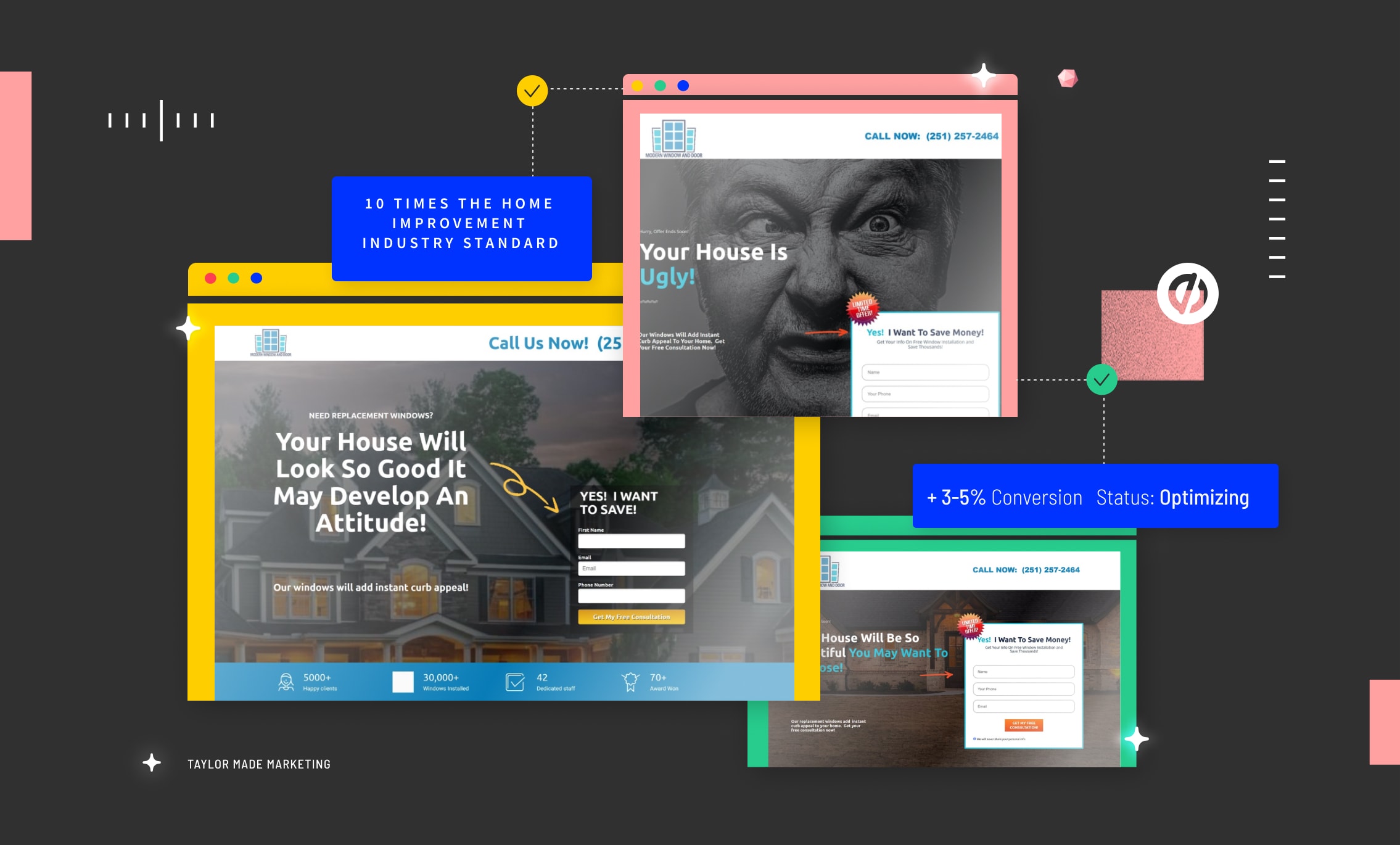[ad_1]
Back in the ‘70s, Jeff Taylor was writing copy for ads at one of his father’s radio stations. He recalls one interaction fondly:
I wrote my first piece of copy. The client read it, looked at me, and said, “You’ll work in an ad agency one day.” I was 12.
Call it fate or natural skill, Jeff has been marketing and growing businesses since 1992—long before “digital” was a part of any agency’s vocabulary. Now, he’s got his own agency. Taylor Made Marketing helps home improvement businesses with lead generation through branding, web design, digital marketing, video production, and more.
But this ain’t your everyday marketing agency. Jeff regularly gets his clients conversion rates above 35%—10 times the home improvement industry standard. That’s led to monster campaign results for the companies that use his services—and Jeff’s well-earned reputation as the handyman who can fix anybody’s marketing.

From analog to digital marketing in a decade
Jeff started out in television and radio advertising. As the internet was going mainstream, he remembers a door-to-door salesman in the early 1990s trying to “con” him into purchasing domain names. Today, some of us buy domains like candy (ahem)—but 30+ years ago, not so much. At the time, Jeff had never heard of domain names and sent the seller on his way.
Although Jeff didn’t buy up any domains, he still got an early start in digital marketing, dipping his toes in the worldwide web towards the turn of the century. Jeff decided to fully move into digital marketing during the financial collapse of 2008, when businesses were struggling to afford more traditional channels like radio and television.
Without skipping a beat, Taylor Made Marketing jumped on the digital marketing bandwagon—and they’ve been driving quality leads for home improvement businesses ever since.
Why traditional A/B testing is great—until it isn’t
Like most marketing agencies, Taylor Made Marketing adopted a traditional approach to building and testing landing pages. They would create multiple pages for clients and A/B test them over several weeks or months to find the winning page. When they discovered the best-performing page, they’d tweak one element and start all over again—and again, and again, until they saw a significant improvement in conversion rates.
Sure, it got them results for their clients—but it was slow, tedious, and the increases were minimal.
Things changed when Taylor Made Marketing discovered Unbounce, and specifically Smart Traffic. Jeff said “buh-bye” to cumbersome and drawn-out A/B testing and “hey, how you doin’?” to AI-optimized landing pages with sky-high conversion rates.
Before Smart Traffic, we used to build landing pages the old fashioned way and do our own A/B testing one page at a time. We gained some increases that way, but once Smart Traffic came out, we could test a whole bunch of landing pages at once.
Smart Traffic uses machine learning to detect traffic patterns and automatically route visitors to the page where they’re most likely to convert. Now, Taylor Made Marketing can test a truckload of pages with multiple variants simultaneously and get faster results for their clients—in as few as 50 visits. That’s lightning fast.
It gives us real-time results back about what’s working. Seeing that real-time data across many landing pages made it very easy for us to make the switch to Smart Traffic.
In fact, he regularly gets 35% conversion rates—when the average conversion rate in the home improvement sector is between 3-5%. Jeff says with results like this, it was a no-brainer to switch all his agency’s landing pages over to Unbounce, which they did several years ago.
Putting AI-powered traffic optimization to work

Thanks to Taylor Made Marketing’s decades of experience in digital marketing and their knowledge of Unbounce’s Smart Traffic, Jeff’s clients experience incredible ROI on ad spend. “On a $10,000 ad spend, we have hit 30:1 ROI with Smart Traffic.” If he’s working with a window installation company, for example, he typically sees a 35% conversion rate (inquiry) with Smart Traffic—with an average close rate (final sale) of 50%. Whoa.
Jeff knows you can have the most amazing, splendiferous, high-converting landing pages—but if you can’t close a lead, it means nothing. You’ve wasted your money.
| Let’s say Acme Home Windows asks Taylor Made Marketing to start a lead generation campaign for a home windows upgrade promotion. |
| For every 100 clicks on the ad, 35 visitors fill out the form to inquire about upgrading the windows in their home—a 35% conversion rate. |
| Now, it’s up to the sales team to close these deals. If they close at a 50% rate, that means 17-18 customers purchase the windows upgrade package. |
| Imagine each window package costs $10,000. That means that Acme Home Windows grosses $170,000-$180,000 on that promotion alone. Not too shabby. |
Some leads don’t require much work to sell—but typically, you need more than headlines and CTAs to book an appointment.
It’s a universal lesson for every industry. If you use landing pages to drive someone to your online shop, and it’s a terrible experience, there’s nothing you can do to convert the customer.
Jeff stresses that every touchpoint of the sales and marketing funnel needs to be effective. He also notes that if a landing page is converting (like the ones he builds for his clients), but the sales don’t match, then you know where your problem is.
Robots never call in sick, robots never lie
Selling the idea of AI marketing tools to his clients comes easy to Jeff. He uses Smart Traffic to generate leads for his own company—and knows first-hand how effective AI can be. But using AI is sometimes intimidating to his clients because they don’t understand it.
[Customers] don’t know what Smart Traffic is, so we just call it AI and assure our clients that our robots are superior to any human marketer on Earth—and it’s true.
Jeff says giving the robot human attributes helps make it feel more approachable.
We’ve used personification where we give the AI human characteristics, like ‘it never calls in sick, it never lies, it’s always 100% accurate, it doesn’t make mistakes, it’s smarter than Einstein, Gates, and Musk combined.
(Time’ll tell on that last one, huh?)
Once clients understand how Smart Traffic fits into Taylor Made Marketing’s team, they’re more open to the idea of using a robot to gain more leads. And with conversion rates like the ones Jeff is pumping out for his clients, any home improvement business owner who doesn’t wanna use AI is missing out.
How AI optimization can accelerate your testing
Taylor Made Marketing has seen a tenfold improvement in results for their clients. So, how are they able to help their clients gain such impressive conversions?
Three tactics have helped Taylor Made Marketing’s home improvement clients turn more leads into customers with Unbounce landing pages and Smart Traffic.
1. Test a ton of pages simultaneously
According to Jeff, one of the best things about Smart Traffic is the ability to test multiple pages at the same time. “We do a lot of testing. We’ll put up 12 pages and find the ones that convert the highest. And then we take those pages and start tweaking them.” The key is testing a whole bunch of pages first, getting those early signals, and then going into testing the finer details.
Once the winning pages are found, Jeff’s team will adjust one thing—the call to action or the image—so they’re only testing a single variable at a time. (That’s what the kids call the OG A/B testing method.)
2. Build pages for specific audiences
You might assume when you find a winning landing page, it’ll with all of your customers. But the reality is, folks in Texas are different from folks in Sydney or Vancouver (holla)—and expecting the same landing pages to work for these different demographics is misleading.
I can take a headline and a hero image that’s working beautifully in Atlanta, Georgia, and move it to Houston, Texas, and it won’t work at all. Or find one that works in Houston and move it to San Diego. And it works twice as good in San Diego as it did in Houston, where it was already working. So geography [of your audience] can definitely affect your results.
The same goes for other aspects of a landing page. Take humor, for example. Jeff’s noticed that using humor in their landing pages has helped improve conversion rates. Humor can offer a little escape from reality and reduce stress, even if for a moment. Used in the wrong context, humor can offend people. Right now Jeff says, “humor is working pretty well, but if there’s a national tragedy, [the advertiser] needs to change gears.”
Knowing your audience is essential. And building landing pages that appeal to different people in different locations has increased conversions for Taylor Made Marketing’s clients.
3. Don’t hesitate to test something new
Video can have a huge impact on conversions—especially if a product or service is being endorsed by a celebrity or influencer. Jeff tells his clients, “if you don’t have an established brand, rent one from someone else.” By that he means, find someone well-known (like a celebrity, athlete, or even someone who’s semi-famous in your hometown) and pay them to endorse you.
We most recently did a test with three very popular landing pages in Nashville, Tennessee. We duplicated them and added video of NFL players endorsing the product. We got almost double the conversion rate on the landing pages with the video. So we were able to prove that video from an NFL player did have a dramatic positive impact on conversions.
One thing Jeff reiterates is that because of Smart Traffic, they are able to test landing pages quickly without having to isolate one thing at a time. The AI learns quickly what type of page resonates with different people, then sends similar people to that page, too.

Get the best possible results from your campaigns
Jeff points out that things have come a long way since the days of marketing in traditional media—particularly when it comes to tracking.
In the old days, people would say, “How do I know if my television ads are working?” I would say, “Did your sales go up?” And that’s about the only answer we could give. If your sales go up, it’s working. If they didn’t, it’s not working. But today we can track everything, and Unbounce makes that so easy for us.
A/B testing is cumbersome and results slow because you can only test one thing at a time. But with AI, you can experiment with lots of different combinations at once—and know exactly what’s working best for a particular audience.
If you’re a digital marketer trying to use a one-size-fits-all approach to help your clients or your company, it might be time to explore how Smart Traffic can help you maximize results. And with results like 35% conversion rates and 300% increase in ROI, Jeff’s proven that the next big step in marketing is AI.
[ad_2]
Source link









